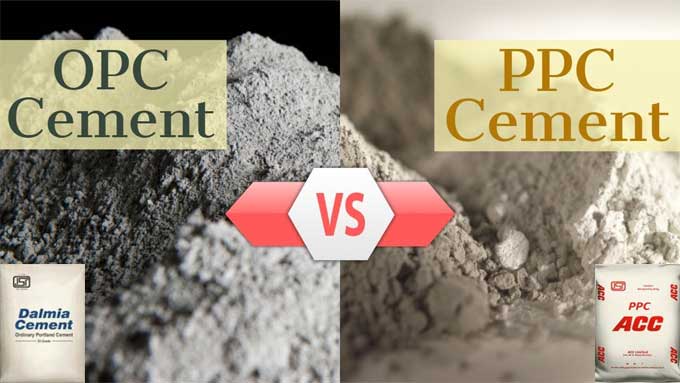
Cement types for construction project: OPC Cement Vs PPC Cement
What do you mean by Cement? What are its uses in Construction?
Cement is a fine, gray powder that is made from a combination of limestone, clay, and other minerals. It is one of the most important building materials in the world and is used in a wide range of construction applications.
Cement is primarily used as a binding agent in concrete, which is a composite material made of cement, sand, gravel, and water. Concrete is used for a variety of construction projects, such as building foundations, roads, bridges, and dams. It is also used in the construction of buildings, such as walls, floors, and roofs.
Cement is also used in the production of mortar, which is a mixture of cement, sand, and water. Mortar is used to bond bricks, stones, and other building materials together. It is commonly used in the construction of walls, chimneys, and other masonry structures.
What is OPC Cement?
OPC cement stands for Ordinary Portland Cement, which is the most commonly used type of cement in the construction industry. It is a type of hydraulic cement that is made by grinding a mixture of limestone, clay, and other minerals and gypsum, which is added to regulate the setting time of the cement.
OPC cement is popularly utilised in a broad range of construction applications, including building foundations, highways, bridges, and precast concrete products. It is noted for its great strength, durability, and adaptability. OPC 33, OPC 43, and OPC 53 are some of the grades available, and they represent the strength of the cement. The most robust and widely used grade is OPC 53.
What are the uses of OPC Cement?
OPC (Ordinary Portland Cement) is the most commonly used type of cement in construction. It has several uses in building and construction, including:
1. Concrete production: OPC is the main component of concrete, and is used in the production of various concrete structures, including buildings, bridges, roads, and dams.
2. Mortar production: OPC is also used in the production of mortar, which is used as a bonding agent between bricks or other masonry units.
3. Stucco production: OPC is used as a binding agent in the production of stucco, which is used as a decorative and protective coating for walls and other structures.
4. Grouting: OPC is used as a binding agent in the production of grout, which is used to fill gaps and voids between tiles or other building materials.
5. Rendering: OPC is used in the production of render, which is used as a coating on walls to provide a smooth and decorative finish.
What is PPC Cement?
PPC cement stands for Portland Pozzolana Cement. It is a type of cement that is commonly used in construction for its durability and strength.
PPC cement is made by combining pozzolanic materials such as fly ash or volcanic ash with clinker, which is the main component of traditional Portland cement. The addition of pozzolanic materials increases the durability and strength of the cement, making it ideal for use in structures that require high-strength and resistance to chemical attack and environmental factors.
PPC cement is commonly used in construction for various purposes, such as building foundations, bridges, dams, and high-rise buildings. It is also used in the construction of roads, pavements, and other infrastructure projects. Its use in construction can help to reduce the carbon footprint of the building and make it more sustainable.
What are the uses of PPC Cement?
PPC (Portland Pozzolana Cement) is a versatile type of cement that finds wide application in the field of construction. Here are some of its uses:
1. Building foundations: PPC cement is used in the construction of building foundations due to its high compressive strength, low heat of hydration, and resistance to chemical attacks.
2. Bridges and Dams: Bridges and dams require cement that can withstand the high water pressure and environmental factors. PPC cement's high strength, durability, and resistance to chemical attacks make it ideal for these structures.
3. High-rise buildings: Due to the high compressive strength of PPC cement, it is used in the construction of high-rise buildings. It helps to make the structure more durable and stable.
4. Infrastructure projects: PPC cement is used in the construction of roads, pavements, and other infrastructure projects. It is used as a binding material for constructing roads and pavements due to its high strength and durability.
5. Mass concrete works: PPC cement is used in mass concrete works such as retaining walls, underground structures, and water storage structures. Its low heat of hydration helps to reduce the risk of cracking in concrete.
What are the Main differences between OPC and PPC Cement?
The main differences between OPC and PPC cement are as follows:
To get more details, watch the following video tutorial.
Video Source: Study Site
1. Raw materials: Limestone is the base material of OPC, while pozzolanic materials like fly ash, volcanic ash, calcined clay, and limestone make up PPC.
2. Manufacturing process: The manufacturing process for both OPC and PPC cement is similar, but PPC cement requires additional grinding and mixing of pozzolanic materials with limestone to achieve the desired properties.
3. Strength: OPC cement is known for its high strength and durability, whereas PPC cement has lower early strength but higher long-term strength.
4. Cost: OPC cement is generally more expensive than PPC cement due to the higher cost of raw materials.
5. Resistance to chemical attack: PPC cement has better resistance to chemical attack, especially in environments where there is high sulfate content in the soil or water.
6. Sustainability: Cement made from PPC is considered more sustainable than cement made from OPC due to the introduction of fly ash and reduced use of limestone, a non-renewable resource.


